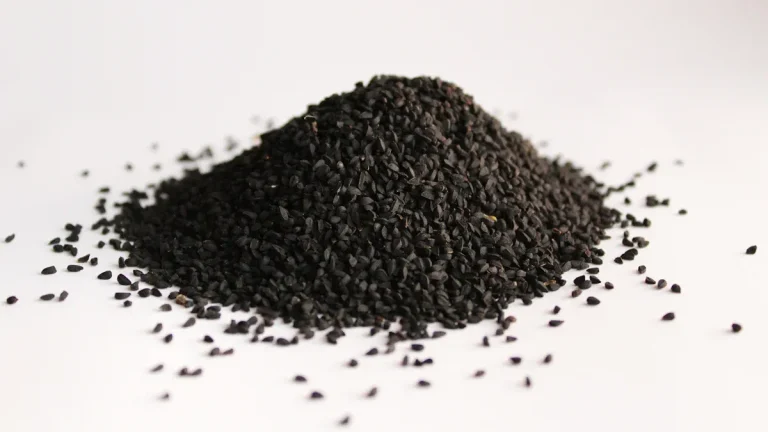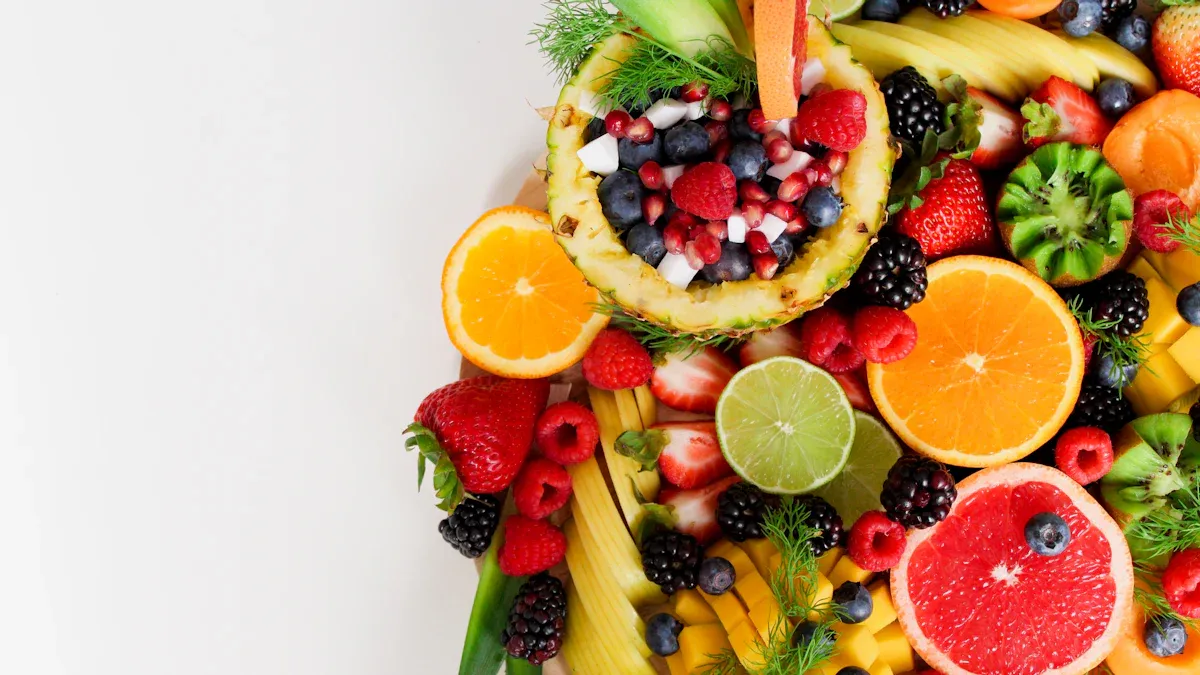
You might not realize how much understanding the types of food can impact your health.
People who eat more whole foods—like nuts, grains, fruits, and vegetables—tend to live longer.
Eating lots of processed foods and red meats often leads to higher health risks.
Your choices truly matter every day.
Key Takeaways
Eating a variety of foods from all five food groups helps you get essential nutrients for good health.
Incorporate more whole foods like fruits, vegetables, and whole grains into your meals to lower health risks and boost energy.
Plan your meals to include a mix of protein, dairy, and healthy fats for a balanced diet that supports your body’s needs.
Types of Food and Major Food Groups
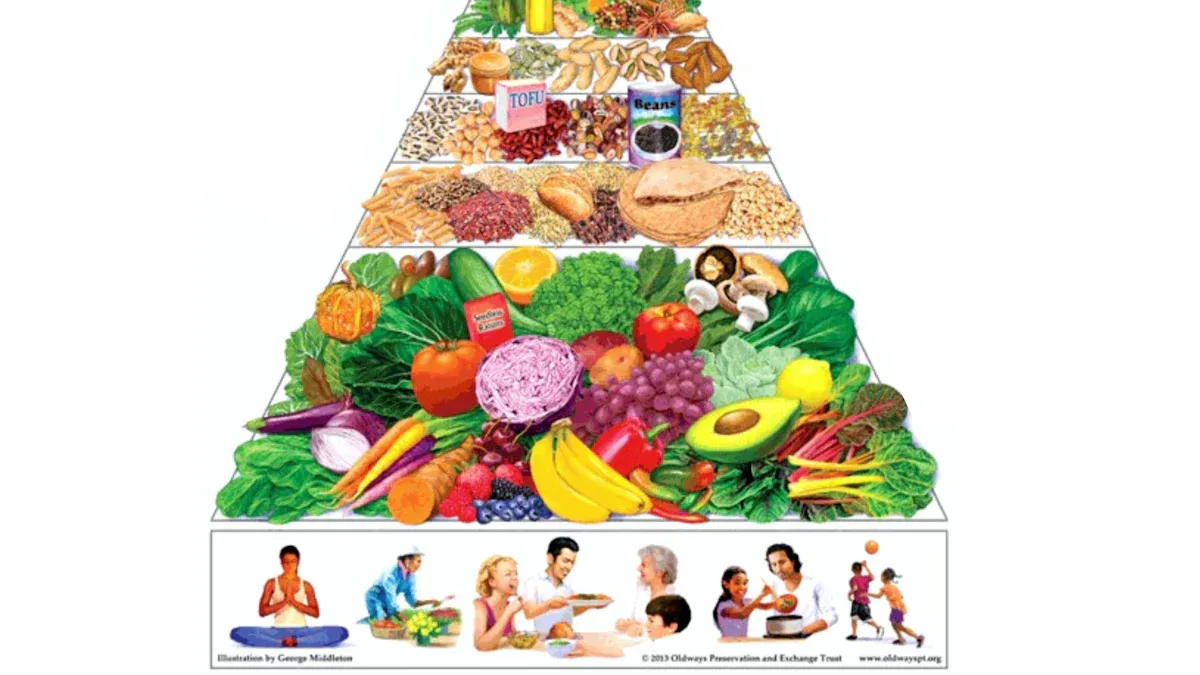
You probably hear about the five food groups all the time, but do you know what they really mean for your daily meals? The USDA MyPlate guidelines break down the types of food you need for a balanced diet. Here’s a quick look at these major food groups:
Food Group | Description |
|---|---|
Fruit Group | Includes all fruits and 100% fruit juice. At least half should come from whole fruit. |
Vegetable Group | Includes any vegetable or 100% vegetable juice, can be eaten raw or cooked. |
Grain Group | Includes foods made from wheat, rice, oats, etc. Examples are bread, pasta, and cereals. |
Protein Group | Includes meat, poultry, seafood, beans, peas, eggs, and nuts, important for building tissues. |
Dairy Group | Includes milk, yogurt, cheese, providing calcium and essential nutrients for bone health. |
You need a variety of foods from each group to get all the nutrients your body needs. Let’s dive into each group and see how you can make your meals healthier and more delicious.
Fruit
Fruit is one of the most colorful and tasty types of food you can eat. You get vitamins, minerals, and fiber from fruits. Some of the most popular fruits around the world include bananas, apples, oranges, mangoes, and watermelons. Each fruit brings something special to your diet.
Fruit | Key Nutrients |
|---|---|
Bananas | Vitamin B6, Vitamin C, Fiber, Magnesium |
Watermelons | Natural sweetness, high water content |
Apples | Dietary fiber, Vitamin C |
Oranges | Vitamin C |
Mangoes | Vitamin C, Vitamin B6, Fiber |
Tip: Try to eat whole fruit instead of just drinking juice. Whole fruit gives you more fiber and keeps you full longer.
Eating fruit every day can help your heart and lower your risk of some diseases. For example, people who eat more fruit and vegetables have a 34% lower risk of heart disease. Green leafy vegetables and some fruits may also help lower your risk of type 2 diabetes.
You should aim for about 2 cups of fruit each day. You can add sliced bananas to your cereal, pack an apple in your lunch, or blend berries into a smoothie. If you want to try something new, add kiwi or pineapple to your snack list. These fruits are loaded with vitamin C and other nutrients that support your immune system.
Vegetables
Vegetables come in many shapes, colors, and flavors. They are a key part of the six classes of foods and help you get the vitamins and minerals you need for healthy eating. There are several types of vegetables, such as leafy greens, root vegetables, and bulb vegetables.
Type of Vegetable | Nutrition Profile | Benefits |
|---|---|---|
Leafy Vegetables | Vitamins A, C, K, magnesium, iron, fiber | Boosts immunity, lowers risk of heart disease and obesity |
Bulb Vegetables | Antioxidants, manganese, vitamins B1, B6, C, copper, calcium | Good for skin, eyes, and nervous system |
Fruit Vegetables | Potassium, vitamins C, B1, K | Helps control blood sugar and supports heart health |
Root Vegetables | Antioxidants, manganese, folate, vitamins A, K, C, fiber, iron | Improves heart health and immune system |
Tuber Vegetables | Fiber, vitamins C, B, potassium, beta carotene | Supports brain and heart health, helps manage diabetes |
Eating a variety of vegetables can help protect you from chronic diseases. Studies show that people who eat more fruit and vegetables have a lower risk of cardiovascular disease. Try to eat at least 2½ cups of vegetables every day.
Note: Mix up your veggies! Add spinach to your eggs, snack on carrot sticks, or toss bell peppers into your stir-fry.
Grains
Grains are a big source of carbohydrates, which give you energy for your day. You’ll find grains in bread, pasta, rice, and cereals. There are two main types of grains: whole grains and refined grains.
Whole grains keep all parts of the grain seed. They are rich in fiber, vitamins, and minerals. Examples include brown rice, oatmeal, and whole wheat bread.
Refined grains have the bran and germ removed. This process takes away fiber and some nutrients. White bread and white rice are common refined grains.
Eating more whole grains can help your heart and keep your blood sugar steady. People who eat at least three servings of whole grains daily have smaller increases in waist size and blood pressure over time. The American Heart Association says whole grains are a key part of a heart-healthy diet.
Try swapping white rice for brown rice or choosing whole wheat pasta for extra fiber and nutrition.
You should aim for 3 to 6 servings of grains each day, with at least half coming from whole grains.
Protein Foods
Protein foods help build and repair your muscles and tissues. You can get protein from both animal and plant sources. Here are some common sources of protein:
Protein Source | Type |
|---|---|
Meat | Complete |
Seafood | Complete |
Poultry | Complete |
Eggs | Complete |
Dairy Products | Complete |
Soy Protein | Complete |
Pea Protein | Complete |
Beans | Incomplete |
Nuts | Incomplete |
Certain Grains | Incomplete |
Variety of Plant Proteins | Complete when combined |
Your body needs protein every day to stay strong. Experts recommend about 0.8 grams of protein per kilogram of body weight for healthy adults. If you want to build or keep muscle, you might need a bit more.
Tip: Mix up your protein foods. Try beans in your chili, add nuts to your salad, or grill some fish for dinner.
Aim for 1 to 2 servings (about 5½ ounces) of protein foods each day. Eating a variety of foods from this group helps you get all the essential amino acids your body needs.
Dairy
Dairy foods are important for strong bones and teeth. You’ll find dairy in milk, cheese, yogurt, and even cottage cheese. These foods are rich in calcium, protein, and vitamin D.
Dairy Product | Nutrients Rich In |
|---|---|
Milk | Protein, Calcium, Vitamin D |
Cheese | Protein, Calcium, Phosphorus |
Yogurt | Protein, Calcium, B Vitamins |
Ice Cream | Calcium, Phosphorus |
Cottage Cheese | Protein, Calcium |
Pudding | Calcium |
Drinking milk or eating yogurt can help you build strong bones, especially when you’re young. Some studies show that dairy, especially milk, is linked to higher bone mineral density. Cheese and yogurt may also help protect your bones as you get older.
Note: If you can’t have regular dairy, try lactose-free milk or fortified plant-based alternatives like soy milk.
You should try to get about 3 servings of dairy each day. Pour milk over your cereal, snack on cheese sticks, or enjoy a cup of yogurt with fruit.
Here’s a quick look at the recommended daily servings for each group:
Food Group | Recommended Servings |
|---|---|
Vegetables | 2½ cups of vegetables daily |
Fruits | 2 cups of fruit daily |
Grains | 3 to 6 servings (3 to 6 oz) daily, with half as whole grains |
Dairy | 3 servings (3 cups) daily |
Protein Foods | 1 to 2 servings (5½ oz equivalents) daily |
Fats and Oil | 2 to 3 servings (9 teaspoons) daily |
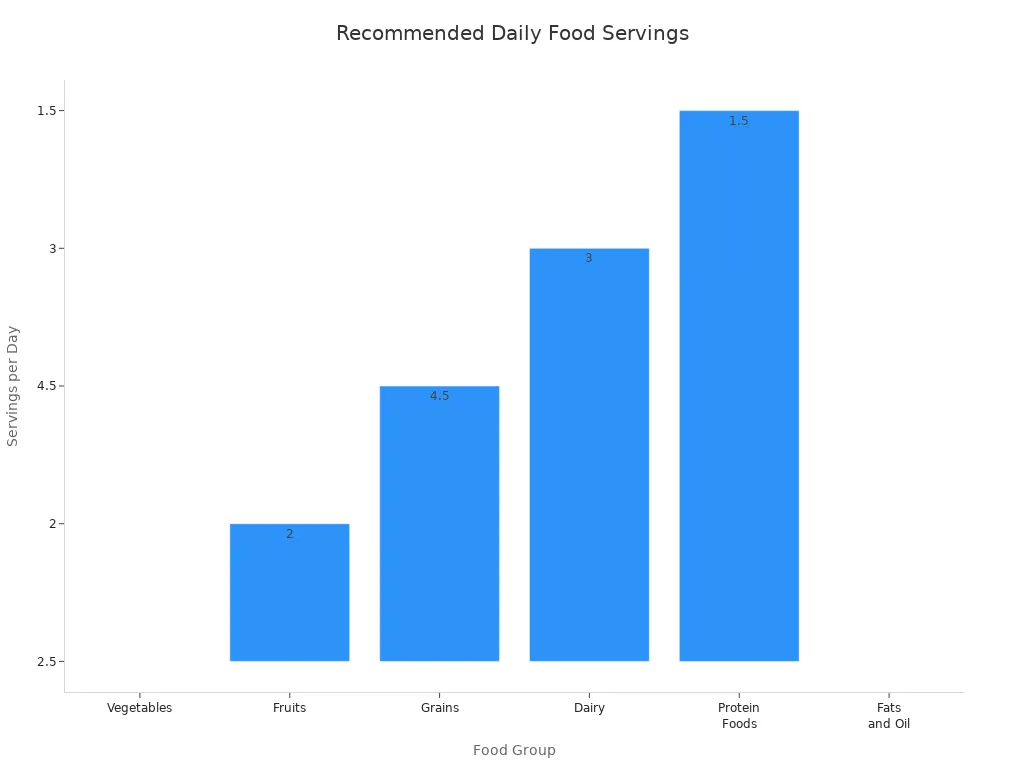
When you include all five food groups in your meals, you get the right mix of carbohydrates, protein, vitamins, and minerals. This helps you stay healthy, feel full of energy, and enjoy a variety of foods every day.
Other Essential Food Groups and Nutrients
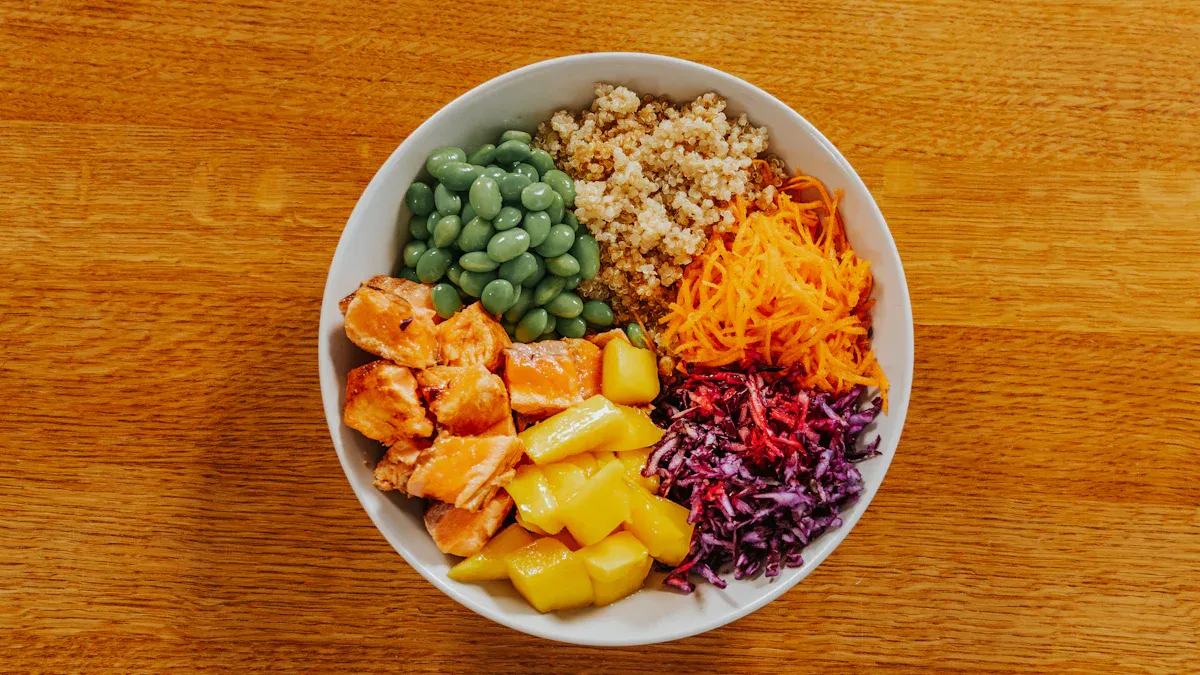
Fats and Oils
You might think fats and oils are bad, but your body needs them for healthy eating. Fats help you absorb fat-soluble vitamins like A, D, E, and K. They also help your body make hormones and keep your cells strong. Here’s what fats do for you:
Help your body absorb vitamins and minerals from foods.
Give you energy and help store it for later.
Support hormone production and keep your brain working well.
Make up cell membranes and help your body use other nutrients.
Not all fats are the same. Try to eat more unsaturated fats from foods like olive oil, nuts, and fatty fish. Limit saturated fats, which you find in butter and fatty meats. Check out these dietary guidelines:
Source | Recommendation |
|---|---|
Dietary Guidelines for Americans | Less than 10% of daily calories from saturated fat |
American Heart Association | Less than 6% of total calories from saturated fat |
Water
Water is the most important nutrient for your body. About 60% of your body is water! You need water for every process, from digesting food to keeping your brain sharp. Most people need about 16 cups of fluids a day for men and 12 cups for women. You get water from drinks and from foods like fruit and vegetables.
Water keeps your body temperature normal.
It helps move nutrients and waste.
Staying hydrated improves memory, attention, and mood.
If you feel tired or can’t focus, try drinking a glass of water. Dehydration can make you forgetful or slow you down.
Vitamins and Minerals
Vitamins and minerals are micronutrients your body needs in small amounts. They help you grow, heal, and stay healthy. You get them from a variety of foods, especially fruit and vegetables, dairy, grains, and sources of protein. Here are some important ones:
Vitamin/Mineral | Food Sources |
|---|---|
Vitamin B12 | Meat, fish, dairy, eggs, cereals |
Folic Acid | Leafy greens, beans, cereals |
Calcium | Dairy, leafy greens, fish |
Iron | Meat, beans, nuts, grains |
Potassium | Bananas, vegetables, fish |
Iodine | Fish, grains, vegetables |
Zinc | Meat, dairy, cereals |
If you don’t get enough vitamins or minerals, you can face problems like weak bones, tiredness, or trouble fighting infections. Eating a mix of nutritious foods helps you meet your nutrient needs.
Balanced Diet Tips
You can build a healthy balanced diet by following a few simple tips:
Fill half your plate with fruit and vegetables at every meal.
Choose whole grains for more dietary fiber and steady energy.
Pick lean sources of protein, like beans, fish, or chicken.
Use healthy fats, such as olive oil or nuts, instead of butter.
Drink water instead of sugary drinks.
Plan your meals to include all types of food and meet your nutrient needs.
Meal planning helps you eat more fruit and vegetables, get enough protein, and follow dietary guidelines. It also makes healthy eating easier every day. Remember, a balanced diet gives you all the macronutrients and micronutrients your body needs for energy, growth, and good health.
You can boost your health by eating a mix of foods from all types of food groups. When you know how fruit, grains, and other foods help your body, you make smarter diet choices. Check out these tips for a balanced diet:
Cost, motivation, and time often block healthy eating.
Nutrition knowledge and food skills help you pick better foods.
Core Elements of a Healthy Dietary Pattern | Recommendations |
|---|---|
Vegetables of all types | Include in daily meals |
Fruits | Include in daily meals |
Grains (especially whole grains) | Include in daily meals |
Low-fat or fat-free dairy | Include in daily meals |
Protein foods | Include in daily meals |
Oils | Use in moderation |
Limit added sugars | Keep to a minimum |
Limit saturated fat | Keep to a minimum |
Limit sodium | Keep to a minimum |
Limit alcohol intake | Keep to a minimum |
Try using what you learned about types of food to build a diet that works for you and your health.
FAQ
What is the healthiest way to include more vegetables in my meals?
You can add chopped veggies to soups, salads, or sandwiches. Try roasting vegetables for extra flavor. Snack on carrot sticks or cucumber slices.
How do I know if I am eating enough protein every day?
Check your meals for foods like eggs, beans, chicken, or fish. You need protein at each meal to help your body build and repair tissues.
Can I get all the nutrients I need from just one type of food?
No, you need a mix of foods. Each type gives you different vitamins, minerals, and energy. Eating a variety helps you stay healthy.

